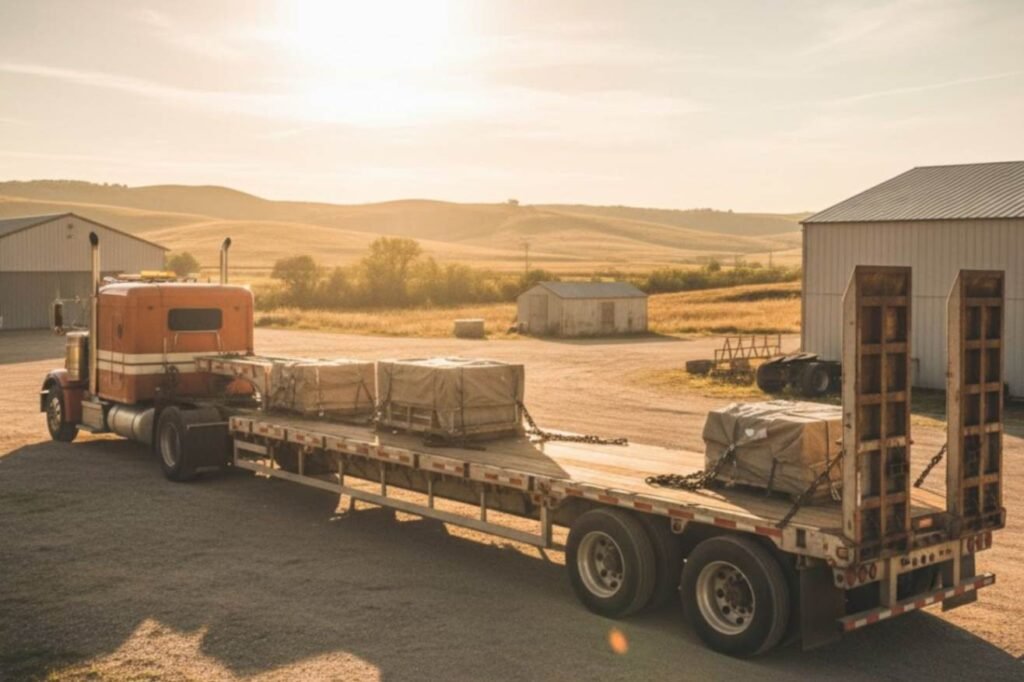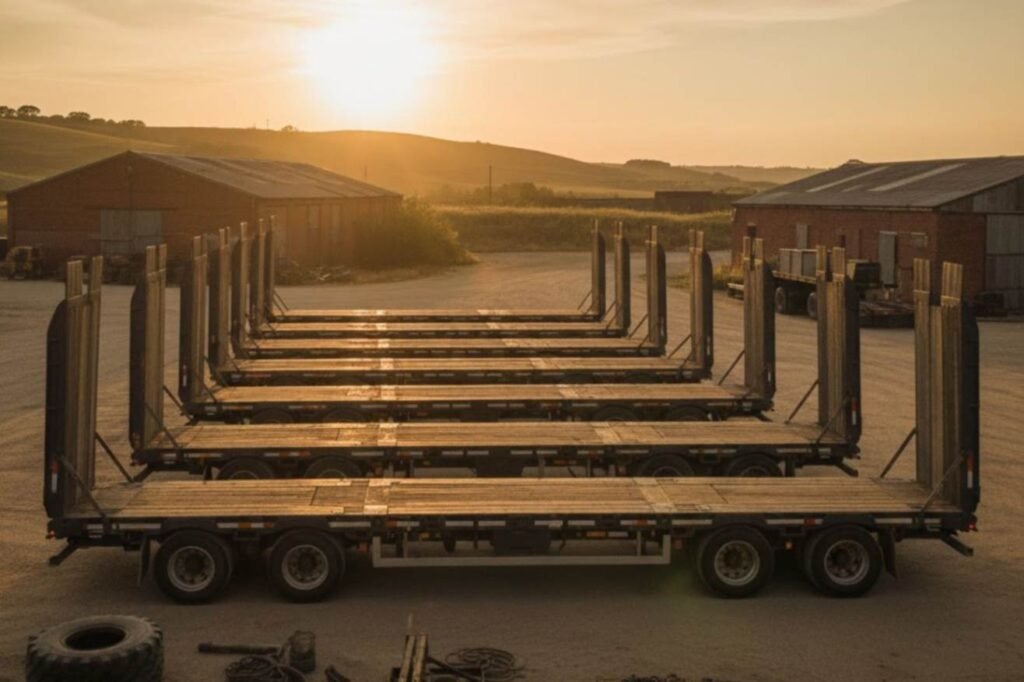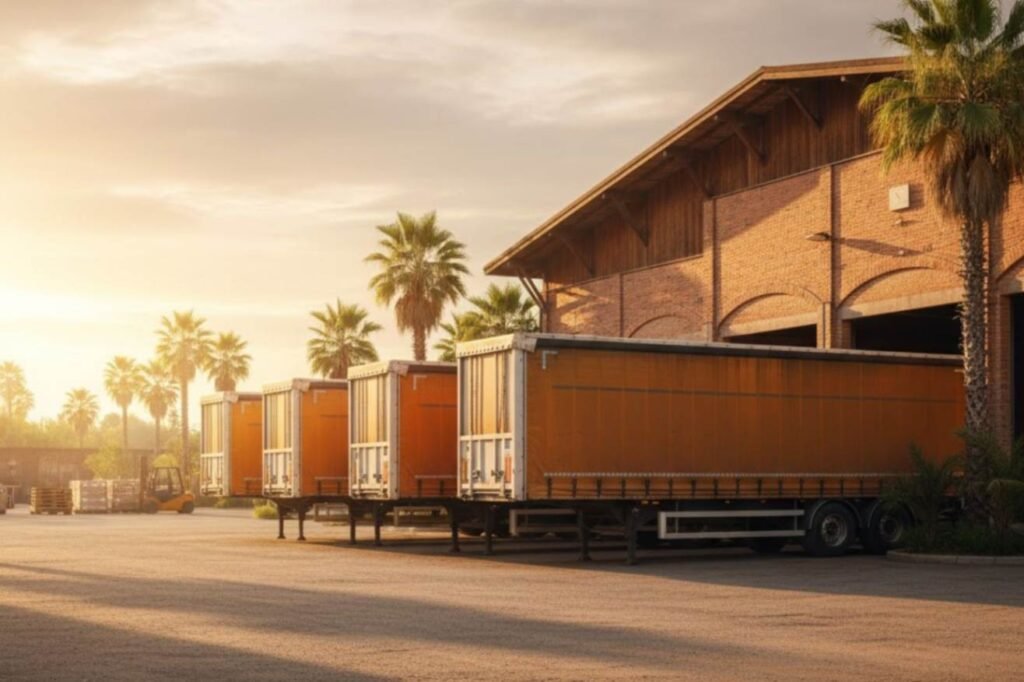If you’re new to logistics, shipping, or heavy haulage, understanding flatbed trailers is essential. These powerful, open-deck systems are the backbone of construction, infrastructure, and manufacturing supply chains, moving everything from heavy machinery and raw materials to packaged goods that simply won’t fit inside a standard box trailer.
This post will serve as your comprehensive blueprint, decoding everything you need to know, from the basic anatomy of these trailers to complex load securement and crucial regulatory standards.
By the time you finish this guide, you will know how to confidently discuss, procure, and operate flatbed trailers safely and efficiently, transforming you from a novice to a well-informed professional in the world of specialized freight.
What Exactly Are Flatbed Trailers?
A flatbed trailer is a foundational piece of equipment in the logistics industry, defined by its simple, open deck with no sides or roof. This minimalist design is crucial for providing maximum flexibility in loading and unloading, accommodating freight that is often oversized, unusually shaped, or too heavy for standard enclosed trailers, using tools like cranes, forklifts, or ramps.
Despite its simple appearance, a flatbed’s construction is engineered for extreme durability and precise weight distribution. The load-bearing surface, or Deck, is a hybrid of durable treated hardwood and steel crossmembers, featuring rub rails and stake pockets along the sides for securing cargo.
The frame consists of robust I-beams made from high-strength steel for maximum capacity or aluminum alloy for weight savings, often using a combination of both materials.
Essential to handling heavy vertical forces are the Suspension and Axles; modern systems frequently employ air-ride suspension for a smoother ride, with the number of axles directly determining the legal weight capacity.
Finally, the Bulkhead at the front is a non-negotiable critical safety feature, designed to shield the truck cab and driver from the load shifting forward during sudden braking. Understanding these core components is key to appreciating the robust capability of a flatbed trailer.
The Core Types of Flatbed Trailers: Finding the Right Deck
While the standard flatbed is highly versatile, the industry relies on several specialized types of flatbed trailers, each designed to overcome a specific logistical challenge, often related to height or weight restrictions.
1. Standard Flatbed Trailer
- Description: The most common type. It maintains a constant deck height from front to back, usually around 5 feet (60 inches) off the ground.
- Maximum Dimensions: Typically 48 or 53 feet long, 8 feet 6 inches wide.
- Ideal Cargo: Construction materials, palletized bricks, steel coils, lumber, and machinery that is neither excessively tall nor overly heavy. The versatility of the standard flatbed trailer makes it the first choice for a wide variety of industrial transport tasks.
2. Step Deck Trailer (or Drop Deck Trailer)
- Description: These flatbed trailers have two deck levels: a smaller upper deck near the tractor and a lower, longer deck behind the gooseneck. The deck “steps down.”
- Advantage: The lower deck height (around 40 inches off the ground) allows them to transport cargo up to 10 feet tall, which is crucial for moving equipment that exceeds the standard road height limits when placed on a traditional flatbed.
- Ideal Cargo: Oversized machinery, large equipment components, or anything that must stay below a 13-foot 6-inch total height limit.

3. Lowboy Trailer (or Double Drop Deck Trailer)
- Description: These are the workhorses of the heavy haul sector. They feature a well, or “deck,” that drops significantly lower than the standard step deck, often placing the load just inches above the pavement. The deck is supported by the front gooseneck and the rear axle assembly.
- Advantage: Designed for maximum height clearance. The low center of gravity is also vital for the safe transport of extremely heavy loads, providing enhanced stability.
- Ideal Cargo: Dozers, excavators, large cranes, and other non-divisible, extremely tall pieces of construction or mining equipment. These specialized flatbed trailers often require special permits and escort vehicles for transport.
4. Extendable Flatbed Trailers (Stretch Trailers)
- Description: These flatbed trailers can physically lengthen, sometimes up to 80 feet or more, via hydraulic mechanisms.
- Advantage: They accommodate extremely long cargo that a standard 53-foot trailer cannot handle, while still providing full support across the entire length.
- Ideal Cargo: Wind turbine blades, structural steel beams, pre-fabricated house components, and very long pipes. Using these extendable flatbed trailers avoids the need for tandem hauling solutions, which can be more complex.

Specialized Flatbed Trailer Variations: Beyond the Basics
To meet the diverse demands of logistics, manufacturers have engineered several other specialized forms of flatbed trailers that address specific needs for protection, access, or loading configuration.
1. Removable Gooseneck (RGN) Trailer
- Functionality: The RGN is a specialized lowboy where the neck connecting the trailer to the tractor can be hydraulically removed.
- Loading: This feature allows equipment to be driven directly onto the lower deck from the front, rather than having to use ramps. This capability is essential for heavy construction equipment that cannot be lifted easily by a crane.
- Use Case: Large construction and military vehicles. RGN flatbed trailers are highly valued for their ease of loading and superior weight-bearing capacity.
2. Conestoga and Curtainside Trailers
- Functionality: While structurally similar to a standard flatbed, these flatbed trailers incorporate a rolling tarp system or rigid curtain system.
- Advantage: They offer the flexibility of a flatbed (easy side/top loading) combined with the weather and security protection of a dry van. The tarp or curtain can be quickly pulled back, providing access, and then securely closed, safeguarding the cargo.
- Use Case: Machinery that must stay dry, finished goods, or high-value loads requiring protection from road debris and weather. This represents a blend of the open-deck and enclosed transport worlds.

3. Side-Kit Flatbeds
- Functionality: These flatbed trailers have removable side panels that are fitted into the stake pockets.
- Advantage: They turn a standard flatbed into a loose-material hauler, perfect for bulk goods that might shift or roll off.
- Use Case: Scrap metal, loose agricultural products, or debris. They are easily convertible back to standard flatbed trailers when needed.
The existence of these specialized flatbed trailers highlights the industry’s commitment to finding the perfect logistical solution for every type of freight imaginable.
The Golden Rules for Flatbed Trailers
The most critical and challenging aspect of operating flatbed trailers is securing the load. Unlike van trailers, where the walls help contain the cargo, flatbed operators are entirely responsible for ensuring the load remains stable, secure, and stationary throughout the journey. Failure to secure a load properly is not only illegal but extremely dangerous.
1. Understanding Securement Forces
Cargo must be secured against five forces that occur during transit:
- Forward Force (Braking): The greatest force; requires 80% of the load’s weight in securement capacity.
- Rearward Force (Acceleration/Reversing): Requires 50% of the load’s weight.
- Lateral Force (Turning): Requires 50% of the load’s weight.
- Vertical Force (Bouncing/Road Shock): Requires 20% of the load’s weight, though gravity helps here.
2. The Tools of Securement
Proper securement relies on a combination of different mechanisms:
- Tiedowns (Straps, Chains, Wire Rope): These are the physical restraints that hold the cargo to the deck of the flatbed trailer.
- Straps (Webbing): Best for lighter, sensitive, or easily scratched loads. They stretch slightly to absorb shock.
- Chains: Required for heavy machinery, steel, or high-weight cargo. Their strength is measured by their Grade (e.g., Grade 70 is standard for transport).
- Blocking and Bracing: Using lumber, steel, or other materials to physically prevent the load from shifting. This is necessary for any load that occupies less than the full width of the flatbed trailer.
- Edge Protection: Corner protectors or sleeves are placed where chains or straps meet the load. This prevents the tiedown from being cut by sharp edges and protects the cargo from being crushed or damaged by the tension of the securement device.
3. Tarping: Protection and Compliance
Tarping is often mandatory for loads that could be damaged by weather or for loads that could lose debris, such as gravel, trash, or small components. High-quality tarps are essential for protecting both the cargo and the public from falling materials. A properly secured tarp on a flatbed trailer ensures compliance and professionalism.
Weight and Dimensions: Navigating Legal and Practical Limits
The maximum legal weights and dimensions for flatbed trailers are highly regulated and vary significantly by jurisdiction (state, province, or country). A successful hauling operation depends on strict adherence to these limits.
1. Gross Vehicle Weight Rating (GVWR)
The total weight of the tractor, the flatbed trailer, the fuel, the driver, and the cargo cannot exceed the Gross Vehicle Weight Rating (GVWR) or, more practically in North America, the Gross Combination Weight Rating (GCWR), which is typically capped at 80,000 pounds (approximately 36,287 kg) for standard tractor-trailer combinations on Interstate highways without a special permit.
2. Axle Weight Laws (The Bridge Formula)
Far more restrictive than the overall GVWR are the axle weight limits, often governed by the “Bridge Formula.” This formula prevents highly concentrated weight from damaging bridges and road surfaces.
It stipulates not just the maximum weight on a single axle (around 20,000 lbs), but the maximum weight allowed on groups of axles based on the distance between them. This is why specialized heavy-haul flatbed trailers often have spread axle groups to legally distribute the load over a greater distance.
3. Permitted Loads (Oversize and Overweight)
When a load exceeds standard legal limits, it becomes an oversize (dimensions) or overweight (weight) load, or often both. Transporting these loads requires:
- Special Permits: A specific, non-transferable permit issued by the state or municipality detailing the exact route and timeframe.
- Escort Vehicles (Pilot Cars): For extremely large loads on flatbed trailers, escort vehicles are required to travel ahead and behind, often with height poles, to ensure clearance and warn other traffic.
- Curfew/Time Restrictions: Oversized loads may only be allowed to travel during specific non-peak hours to minimize traffic disruption.
A meticulous approach to weight distribution and permitting is the hallmark of any professional flatbed operation. Never attempt to haul a load on your flatbed trailers that you suspect is overweight or over-dimensioned without the necessary legal documentation.
Read: Common Flatbed Trailer Sizes and Weight Limits
Buying vs. Renting Flatbed Trailers: The Strategic Decision
When scaling a logistics operation or simply starting a business that requires the use of flatbed trailers, a major strategic decision involves acquisition: should you buy new or used, or should you rent/lease?
1. When to Buy (New or Used)
- High Utilization: If your business requires the use of flatbed trailers 80% of the time or more, buying is usually the most economical choice in the long run. Owning the asset builds equity and provides tax benefits through depreciation.
- Specialized Needs: If your freight requires a highly customized trailer (e.g., a unique-length extendable or a specific multi-axle configuration), purchasing ensures you have the exact tool needed, customized to your specifications.
- Investment: For established companies, the purchase of a fleet of flatbed trailers is considered a capital investment that stabilizes operational costs over time.
2. When to Rent or Lease
- Fluctuating Demand: If your need for flatbed trailers is seasonal, project-based, or sporadic, renting is superior. It prevents expensive, specialized equipment from sitting idle and depreciating.
- Testing Equipment: Renting allows a company to test different types of flatbed trailers (e.g., steel vs. aluminum, tandem vs. tri-axle) before committing to a large purchase.
- Maintenance: Leasing agreements often include maintenance and repair packages, which can be a massive advantage for smaller companies that lack extensive in-house service capabilities. This simplifies the operating budget significantly.
The decision often boils down to predictable utilization and capital availability. A strong business case should always precede the acquisition of any new flatbed trailers.
Essential Maintenance and Safety Checks for Flatbed Trailers
The harsh reality of the transport environment means that flatbed trailers are constantly exposed to stress, road debris, and weather. A rigorous maintenance schedule is not merely a best practice; it is a safety imperative.
1. Pre-Trip Inspection (The Walkaround)
Every driver must perform a thorough check before operating a flatbed trailer. This includes:
- Tire Condition: Check inflation (PSI) and tread depth. Look for cuts, bulges, or uneven wear that could indicate alignment problems.
- Brake System: Ensure brake linings are adequate and all brake hoses and connections are secure and leak-free. Brake failure on a heavily loaded flatbed trailer is catastrophic.
- Lights and Reflectors: Confirm all marker lights, turn signals, and brake lights are fully operational. Visibility is paramount, especially when hauling wide or long loads.
- Deck and Frame: Inspect the deck for damage, cracks in the wood, or missing tie-down hardware. Check the main beams for signs of stress or fatigue.
- Securement Gear: Ensure all chains, binders, straps, and tarps are on the trailer and in good condition, ready for use. Faulty securement equipment is a major safety risk.
2. Regular Preventive Maintenance (PM)
A detailed PM schedule should include:
- Axle and Suspension Service: Regular greasing of bearings and inspection of the suspension components (springs, air bags, shock absorbers). Misaligned axles cause tire wear and fuel inefficiency.
- Frame Inspection: Weld integrity checks, especially where the neck meets the main beams and around the kingpin area. Flatbed trailers must withstand constant torsional stress.
- Corrosion Control: Regular cleaning and attention to rust, especially in areas where road salts are used. Aluminum flatbed trailers require different protective measures than their steel counterparts.
Investing in the upkeep of your flatbed trailers drastically increases their lifespan, improves fuel economy, and, most importantly, protects your drivers and the public. A well-maintained piece of equipment reflects professionalism and operational excellence.
The Future of Flatbed Trailers: Innovation and Technology
The world of flatbed trailers is not static. Innovation continues to push the boundaries of what these workhorses can achieve, primarily focusing on safety, efficiency, and data integration.
1. Lightweighting and Materials
The ongoing shift toward high-strength, lightweight steel and advanced aluminum alloys is crucial. Reducing the trailer’s tare (empty) weight translates directly into higher payload capacity, maximizing the revenue-per-trip potential for any standard flatbed trailer operation while adhering to the 80,000-pound limit. Manufacturers are constantly seeking marginal gains in weight reduction.
2. Telematics and Smart Flatbed Trailers
Telematics devices are increasingly integrated into flatbed trailers. These systems monitor:
- Tire Pressure Monitoring Systems (TPMS): Real-time alerts for low pressure or temperature, preventing dangerous blowouts.
- Geofencing and GPS Tracking: Enhanced security and accurate location data for high-value cargo.
- Brake and Light Diagnostics: Predictive maintenance alerts that signal a fault before it leads to a road breakdown.
These smart flatbed trailers leverage data to improve dispatch efficiency and safety protocols, making operations much more data-driven than ever before.
3. Enhanced Securement Technologies
New automated securement systems are under development to replace manual ratcheting and chaining. While traditional methods remain the industry standard, innovations like automated tarping systems and integrated sensors that measure strap tension are making the lives of flatbed drivers easier and the securement process more consistent and reliable. The evolution of flatbed trailers continues to prioritize the safety of the driver and the integrity of the load.
Conclusion
You now possess the foundational knowledge required to navigate the complex world of flatbed trailers. From the simple standard deck to the sophisticated RGN, you understand the purpose, construction, and operational challenges associated with this essential equipment.
Remember, success in flatbed hauling hinges on two things: meticulous planning (knowing the limits and securing the permits) and unwavering commitment to safety (mastering the securement rules).
If you are looking to acquire dependable, high-performance flatbed trailers that are built for maximum payload and minimum downtime, look no further than Kinema Trailers.
Our range of steel and aluminum decks, step-decks, and specialized hauling solutions is engineered to withstand the toughest demands of the logistics industry. Contact Kinema Trailers today to speak with a hauling expert and find the perfect trailer to begin dominating the road!
FAQs
1. What is the key difference between a Standard Flatbed, a Step Deck, and a Lowboy trailer?
The difference is the deck height, which dictates the maximum cargo height. A Standard Flatbed has a uniform high deck (around 60 inches). A Step Deck has a lower rear deck (around 40 inches) to carry taller items within legal height limits. A Lowboy has the lowest deck (the well), designed specifically for the tallest, heaviest, and non-divisible loads.
2. What are the three essential forces cargo must be secured against on a flatbed?
Cargo must be secured against Forward Force (braking), Rearward Force (acceleration), and Lateral Force (turning). Federal safety regulations require the securement system to be capable of resisting 80% of the load’s weight in the forward direction and 50% in the rearward and lateral directions to ensure stability on the road.
3. What is the maximum legal weight (GVWR) for a standard flatbed trailer load?
While the Gross Combination Weight Rating (GCWR) is typically 80,000 pounds for the entire truck and trailer on US Interstates, the actual maximum load on a flatbed is often limited by state-specific axle weight laws (the Bridge Formula). These rules prevent weight concentration from damaging infrastructure, meaning the load must be distributed correctly to utilize the full 80,000 lbs.
4. When is renting a flatbed trailer a better option than buying one?
Renting or leasing is generally preferred when a business has fluctuating or seasonal demand for flatbeds, or when they need to transport specialized, infrequent cargo (like an RGN). Leasing also simplifies operational budgets by often including maintenance and repair packages, which reduces the burden of asset ownership.
5. Why do some flatbed trailers use a rolling tarp system like a Conestoga?
These systems are used to combine the superior loading flexibility of a flatbed (allowing overhead or side access) with the crucial weather and security protection of a dry van. The tarp can be quickly rolled back for easy access and then sealed shut, protecting sensitive machinery or finished goods from the elements and road debris.









Leave a Reply